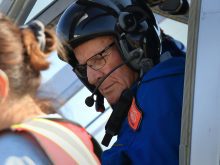Q: I am planning to take a long airplane flight across the continent. Do you have any suggestions for avoiding getting blood clots in the legs? I am an elderly female.
A: An extensive review by the World Health Association in 2001 concluded that an association probably exists between air travel and venous thrombosis.
Note the word “probably.” Much has been written in the media about economy class syndrome but there has been more hype than reality. It is quite rare, and who knows whether or not the passengers had a pre-existing medical condition that would predispose them to blood clots?
Read Also

Support needed at all levels for high-value solar projects
Farmers, rural municipalities and governments should welcome any opportunity to get involved in large-scale solar power installations, say agrivoltaics proponents.
Examples of this would be someone with a recent history of surgery, cancer, heart failure or recent leg fracture.
Deep vein thrombosis can also occur after any long journey in other types of transportation such as buses, trains or cars.
Older travellers like you are at increased risk. Also at risk are pregnant women, women on the birth control pill or hormone replacement therapy and overweight individuals who are more likely to be squeezed into their seats.
The theory is that travellers’ thrombosis occurs because the legs are inactive and the blood flow is too slow. In addition, dehydration may occur after travelling for more than six hours and oxygen levels in the pressurized airplane cabin may be reduced to save on fuel costs.
What can you do to prevent blood clots in the legs? Make sure you are dressed comfortably in loose fitting clothing and shoes. Compression stockings may be helpful, especially if you suffer from varicose veins. Assuming you have no bleeding problems or ulcers, you could also take one Aspirin a day starting the day before leaving and continuing for a day after you arrive.
Try to get an aisle seat so you can stretch and flex your legs as often as possible. If you can, try to exercise a little every 20 minutes, and make several trips to the bathrooms at the rear of the plane so that you get a short walk.
Symptoms of deep vein thrombosis, which include calf pain and swelling of the lower leg, typically do not occur until two or three days after travelling and sometimes even several weeks later. More serious illness, such as pulmonary embolism, can be prevented if you seek medical help as soon as you notice any signs. Anticoagulants (blood thinners) may be needed.
Clare Rowson is a medical doctor with a practice near Belleville, Ont. Her columns are intended for general information only. Individuals are encouraged to also seek the advice of their own doctor regarding medical questions and treatments.














